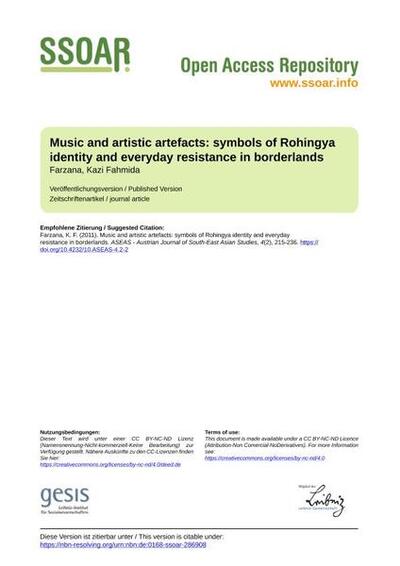Javascript must be enabled to continue!
Music and artistic artefacts: symbols of Rohingya identity and everyday resistance in borderlands
View through Europeana Collections
"This study looks at the creation of music and art by Rohingya refugees in Bangladesh as a symbol of social resistance and identity. Ethnographic research on the Rohingyas' use of music and art suggests that these non-conventional means play an important role in communicating their coherent identity and expressing their resistance to the discrimination and oppression experienced in their country of origin as well as in their exile in Bangladesh. This informal resistance is used to keep their memory alive, to transmit that history through verbal and visual expressions to the new generations, and to communicate information about themselves to outsiders. This article posits that these forms of expression, while suggestive of their identity and everyday resistance, occur mostly in an informal and indirect form, rather than in direct confrontation and protest. These informal means also reflect the Rohingyas' pragmatism and coping strategies for living in the borderlands." (author's abstract)
GESIS - Leibniz Institute for the Social Sciences. Library Cologne
Title: Music and artistic artefacts: symbols of Rohingya identity and everyday resistance in borderlands
Description:
"This study looks at the creation of music and art by Rohingya refugees in Bangladesh as a symbol of social resistance and identity.
Ethnographic research on the Rohingyas' use of music and art suggests that these non-conventional means play an important role in communicating their coherent identity and expressing their resistance to the discrimination and oppression experienced in their country of origin as well as in their exile in Bangladesh.
This informal resistance is used to keep their memory alive, to transmit that history through verbal and visual expressions to the new generations, and to communicate information about themselves to outsiders.
This article posits that these forms of expression, while suggestive of their identity and everyday resistance, occur mostly in an informal and indirect form, rather than in direct confrontation and protest.
These informal means also reflect the Rohingyas' pragmatism and coping strategies for living in the borderlands.
" (author's abstract).
Related Results
Evidence against Pathway-Selective Hepatic Insulin Resistance in Mice
Evidence against Pathway-Selective Hepatic Insulin Resistance in Mice
Insulin suppresses hepatic glucose production and increases hepatic de novo lipogenesis (DNL). Paradoxically, hepatic DNL remains elevated in insulin-resistant subjects, leading to...
Petra Santa Cruz Stevens and the sexual and racial modalities of property relations in the nineteenth-century Arizona–Sonora borderlands
Petra Santa Cruz Stevens and the sexual and racial modalities of property relations in the nineteenth-century Arizona–Sonora borderlands
The 1890s were a period of tremendous social and political upheaval. The intimate nature of boom-bust economies and the end of the Indian wars influenced US–Mexico borderlands soci...
Retuning music teaching: Online music tutorials preferences as predictors of amateur musicians’ music self-efficacy in informal music learning
Retuning music teaching: Online music tutorials preferences as predictors of amateur musicians’ music self-efficacy in informal music learning
Music self-efficacy has been acknowledged as a strong predictor of successful performance among musicians and music students, but is less researched among amateur musicians. The pu...
Recreating Prometheus
Recreating Prometheus
Prometheus, chained to a rock, having his liver pecked out by a great bird only for the organ to grow back again each night so that the torture may be repeated afresh the next day ...
Music education undergraduates’ construction of music teacher role-identity
Music education undergraduates’ construction of music teacher role-identity
The purpose of this study was to explore Chinese music education undergraduates’ music teacher role-identities. Data were collected through focus groups and individual interviews. ...
Pop and world music in Dutch music education: two cases of authentic learning in music teacher education and secondary music education
Pop and world music in Dutch music education: two cases of authentic learning in music teacher education and secondary music education
Popular and world music play an important role in Dutch music education. This article examines two case studies that illustrate authentic music learning environments in which these...
Music and communication in music psychology
Music and communication in music psychology
There is a general consensus that music is both universal and communicative, and musical dialogue is a key element in much music-therapeutic practice. However, the idea that music ...
Tempo in Baroque Music and Dance
Tempo in Baroque Music and Dance
Growing interest in studies on the relationship between music and movement has given rise to many paradigms and theories, including embodied approaches that provide interesting met...
Recent Results
Portrait of the Comte de Caylus
Portrait of the Comte de Caylus
A tondo profile portrait of the Comte de Caylus facing left....
Abstract relations: bibliography and the infra-structures of modern mathematics
Abstract relations: bibliography and the infra-structures of modern mathematics
AbstractBeginning at the end of the nineteenth century, systematic scientific abstracting played a crucial role in reconfiguring the sciences on an international scale. For mathema...
On the Conditions of Imperfect Neutrosophic Duplets and Imperfect Neutrosophic Triplets
On the Conditions of Imperfect Neutrosophic Duplets and Imperfect Neutrosophic Triplets
In any neutrosophic ring R(I), an imperfect neutrosophic duplet consists of two elements x,y with a condition xy=yx=x and an imperfect neutrosophic triplet consists of three elemen...
Christopher Bucklow, Guest (R.B.) 1:36 pm 19th November 1993 and Guest (C.B.) 4:44 p.m., 17th June (1996)
Christopher Bucklow, Guest (R.B.) 1:36 pm 19th November 1993 and Guest (C.B.) 4:44 p.m., 17th June (1996)
Two unique dye destruction photograms, 95.3 × 69.9 cm...











 Your session has timed out for security reasons.
Your session has timed out for security reasons.